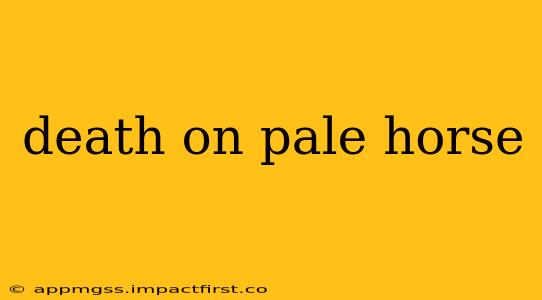Agatha Christie's Death on the Pale Horse stands as a chilling testament to her mastery of suspense and intrigue. Published in 1961, this novel delves into the dark world of murder, occult practices, and a shadowy organization known only as "The Three," leaving readers breathless until the very end. This exploration will delve into the intricacies of the plot, examining its key themes and answering some frequently asked questions surrounding this captivating mystery.
What is the mystery in Death on the Pale Horse?
The central mystery revolves around a seemingly innocuous list of names found in the possession of a recently deceased man. Mark Easterbrook, a seemingly ordinary insurance agent, stumbles upon this list, triggering a chain of events that lead him into a dangerous game of cat and mouse with a sinister organization. Each name on the list mysteriously precedes a death, suggesting a meticulously planned series of murders. Easterbrook, driven by his insatiable curiosity and a sense of justice, embarks on a perilous quest to uncover the truth behind "The Three" and their deadly operation, ultimately facing significant risks to his own life. The mystery lies not only in identifying the killers but also in understanding their motives and the intricate web of connections that bind their victims.
Who are "The Three" in Death on the Pale Horse?
"The Three" are a clandestine organization responsible for carrying out contract killings, operating outside the bounds of the law. Their methods are subtle and efficient, leaving little to no trace of their involvement. Christie masterfully keeps their identity obscured for much of the novel, building suspense and intrigue as Easterbrook slowly uncovers their operations and the individuals involved. The true nature of "The Three" and the extent of their influence adds a layer of complexity to the narrative, making their exposure a crucial element of the story's resolution. They are not merely assassins; they represent a chillingly efficient and organized system of death, preying on vulnerable individuals and operating with impunity.
What is the role of the pale horse in Death on the Pale Horse?
The pale horse is a powerful symbol, drawing from the Book of Revelation. In Christie's novel, it's a metaphorical representation of death itself and the ominous presence of "The Three," suggesting an impending doom for those on their list. The image acts as a constant reminder of the lethal nature of the organization and the danger that lurks around every corner for Easterbrook and those connected to the mysterious list. It is not a literal horse, but a symbolic embodiment of the organization's deadly work. This adds a layer of symbolic depth to the novel, hinting at the larger forces at play and the devastating consequences of their actions.
Is Death on the Pale Horse a good mystery novel?
Death on the Pale Horse is widely considered one of Christie's finest works, showcasing her remarkable ability to craft suspenseful plots and memorable characters. The novel successfully blends elements of mystery, thriller, and even a touch of the supernatural, creating a unique and compelling reading experience. The gradual unraveling of the mystery, the complex characters, and the dark themes make it a highly rewarding read for fans of the genre. Its exploration of dark themes and the persistent sense of unease elevates it beyond a typical whodunnit, solidifying its place as a significant contribution to the world of mystery literature.
What is the significance of Ariadne Oliver in Death on the Pale Horse?
Ariadne Oliver, Christie's recurring fictional character, serves as a contrasting element to the grim world of "The Three." Her presence brings a touch of humor and levity to the narrative, though her involvement is ultimately crucial in furthering the investigation. While her detective skills might not be as sharp as Poirot’s, her insights and observations prove valuable in illuminating certain aspects of the case, providing a counterpoint to the relentless darkness. The inclusion of Ariadne Oliver is a testament to Christie's willingness to blend her diverse cast of characters, showcasing their unique contributions to solving complex mysteries.
In conclusion, Death on the Pale Horse is more than just a thrilling mystery; it's a chilling exploration of human fallibility, the seductive power of dark forces, and the relentless pursuit of justice. Its enduring popularity and critical acclaim solidify its place as a timeless classic in the world of crime fiction.
